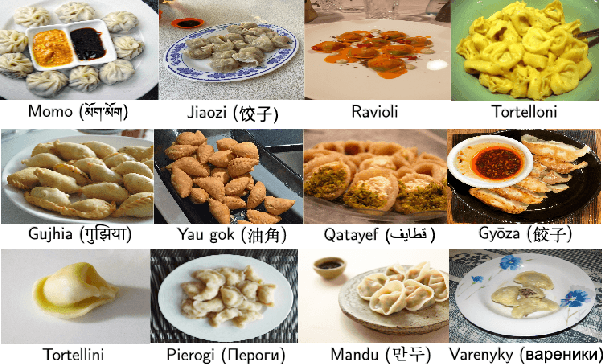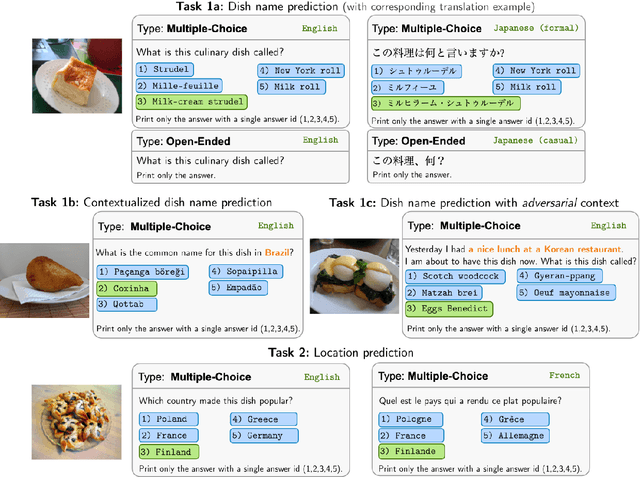David Anugraha
Crowdsource, Crawl, or Generate? Creating SEA-VL, a Multicultural Vision-Language Dataset for Southeast Asia
Mar 10, 2025Abstract:Southeast Asia (SEA) is a region of extraordinary linguistic and cultural diversity, yet it remains significantly underrepresented in vision-language (VL) research. This often results in artificial intelligence (AI) models that fail to capture SEA cultural nuances. To fill this gap, we present SEA-VL, an open-source initiative dedicated to developing high-quality, culturally relevant data for SEA languages. By involving contributors from SEA countries, SEA-VL aims to ensure better cultural relevance and diversity, fostering greater inclusivity of underrepresented languages in VL research. Beyond crowdsourcing, our initiative goes one step further in the exploration of the automatic collection of culturally relevant images through crawling and image generation. First, we find that image crawling achieves approximately ~85% cultural relevance while being more cost- and time-efficient than crowdsourcing. Second, despite the substantial progress in generative vision models, synthetic images remain unreliable in accurately reflecting SEA cultures. The generated images often fail to reflect the nuanced traditions and cultural contexts of the region. Collectively, we gather 1.28M SEA culturally-relevant images, more than 50 times larger than other existing datasets. Through SEA-VL, we aim to bridge the representation gap in SEA, fostering the development of more inclusive AI systems that authentically represent diverse cultures across SEA.
MetaMetrics-MT: Tuning Meta-Metrics for Machine Translation via Human Preference Calibration
Nov 01, 2024Abstract:We present MetaMetrics-MT, an innovative metric designed to evaluate machine translation (MT) tasks by aligning closely with human preferences through Bayesian optimization with Gaussian Processes. MetaMetrics-MT enhances existing MT metrics by optimizing their correlation with human judgments. Our experiments on the WMT24 metric shared task dataset demonstrate that MetaMetrics-MT outperforms all existing baselines, setting a new benchmark for state-of-the-art performance in the reference-based setting. Furthermore, it achieves comparable results to leading metrics in the reference-free setting, offering greater efficiency.
WorldCuisines: A Massive-Scale Benchmark for Multilingual and Multicultural Visual Question Answering on Global Cuisines
Oct 16, 2024



Abstract:Vision Language Models (VLMs) often struggle with culture-specific knowledge, particularly in languages other than English and in underrepresented cultural contexts. To evaluate their understanding of such knowledge, we introduce WorldCuisines, a massive-scale benchmark for multilingual and multicultural, visually grounded language understanding. This benchmark includes a visual question answering (VQA) dataset with text-image pairs across 30 languages and dialects, spanning 9 language families and featuring over 1 million data points, making it the largest multicultural VQA benchmark to date. It includes tasks for identifying dish names and their origins. We provide evaluation datasets in two sizes (12k and 60k instances) alongside a training dataset (1 million instances). Our findings show that while VLMs perform better with correct location context, they struggle with adversarial contexts and predicting specific regional cuisines and languages. To support future research, we release a knowledge base with annotated food entries and images along with the VQA data.
MetaMetrics: Calibrating Metrics For Generation Tasks Using Human Preferences
Oct 03, 2024Abstract:Understanding the quality of a performance evaluation metric is crucial for ensuring that model outputs align with human preferences. However, it remains unclear how well each metric captures the diverse aspects of these preferences, as metrics often excel in one particular area but not across all dimensions. To address this, it is essential to systematically calibrate metrics to specific aspects of human preference, catering to the unique characteristics of each aspect. We introduce MetaMetrics, a calibrated meta-metric designed to evaluate generation tasks across different modalities in a supervised manner. MetaMetrics optimizes the combination of existing metrics to enhance their alignment with human preferences. Our metric demonstrates flexibility and effectiveness in both language and vision downstream tasks, showing significant benefits across various multilingual and multi-domain scenarios. MetaMetrics aligns closely with human preferences and is highly extendable and easily integrable into any application. This makes MetaMetrics a powerful tool for improving the evaluation of generation tasks, ensuring that metrics are more representative of human judgment across diverse contexts.
URIEL+: Enhancing Linguistic Inclusion and Usability in a Typological and Multilingual Knowledge Base
Sep 27, 2024



Abstract:URIEL is a knowledge base offering geographical, phylogenetic, and typological vector representations for 7970 languages. It includes distance measures between these vectors for 4005 languages, which are accessible via the lang2vec tool. Despite being frequently cited, URIEL is limited in terms of linguistic inclusion and overall usability. To tackle these challenges, we introduce URIEL+, an enhanced version of URIEL and lang2vec addressing these limitations. In addition to expanding typological feature coverage for 2898 languages, URIEL+ improves user experience with robust, customizable distance calculations to better suit the needs of the users. These upgrades also offer competitive performance on downstream tasks and provide distances that better align with linguistic distance studies.
ProxyLM: Predicting Language Model Performance on Multilingual Tasks via Proxy Models
Jun 14, 2024



Abstract:Performance prediction is a method to estimate the performance of Language Models (LMs) on various Natural Language Processing (NLP) tasks, mitigating computational costs associated with model capacity and data for fine-tuning. Our paper introduces ProxyLM, a scalable framework for predicting LM performance using proxy models in multilingual tasks. These proxy models act as surrogates, approximating the performance of the LM of interest. By leveraging proxy models, ProxyLM significantly reduces computational overhead on task evaluations, achieving up to a 37.08x speedup compared to traditional methods, even with our smallest proxy models. Additionally, our methodology showcases adaptability to previously unseen languages in pre-trained LMs, outperforming the state-of-the-art performance by 1.89x as measured by root-mean-square error (RMSE). This framework streamlines model selection, enabling efficient deployment and iterative LM enhancements without extensive computational resources.
Predicting Machine Translation Performance on Low-Resource Languages: The Role of Domain Similarity
Feb 04, 2024Abstract:Fine-tuning and testing a multilingual large language model is expensive and challenging for low-resource languages (LRLs). While previous studies have predicted the performance of natural language processing (NLP) tasks using machine learning methods, they primarily focus on high-resource languages, overlooking LRLs and shifts across domains. Focusing on LRLs, we investigate three factors: the size of the fine-tuning corpus, the domain similarity between fine-tuning and testing corpora, and the language similarity between source and target languages. We employ classical regression models to assess how these factors impact the model's performance. Our results indicate that domain similarity has the most critical impact on predicting the performance of Machine Translation models.
 Add to Chrome
Add to Chrome Add to Firefox
Add to Firefox Add to Edge
Add to Edge